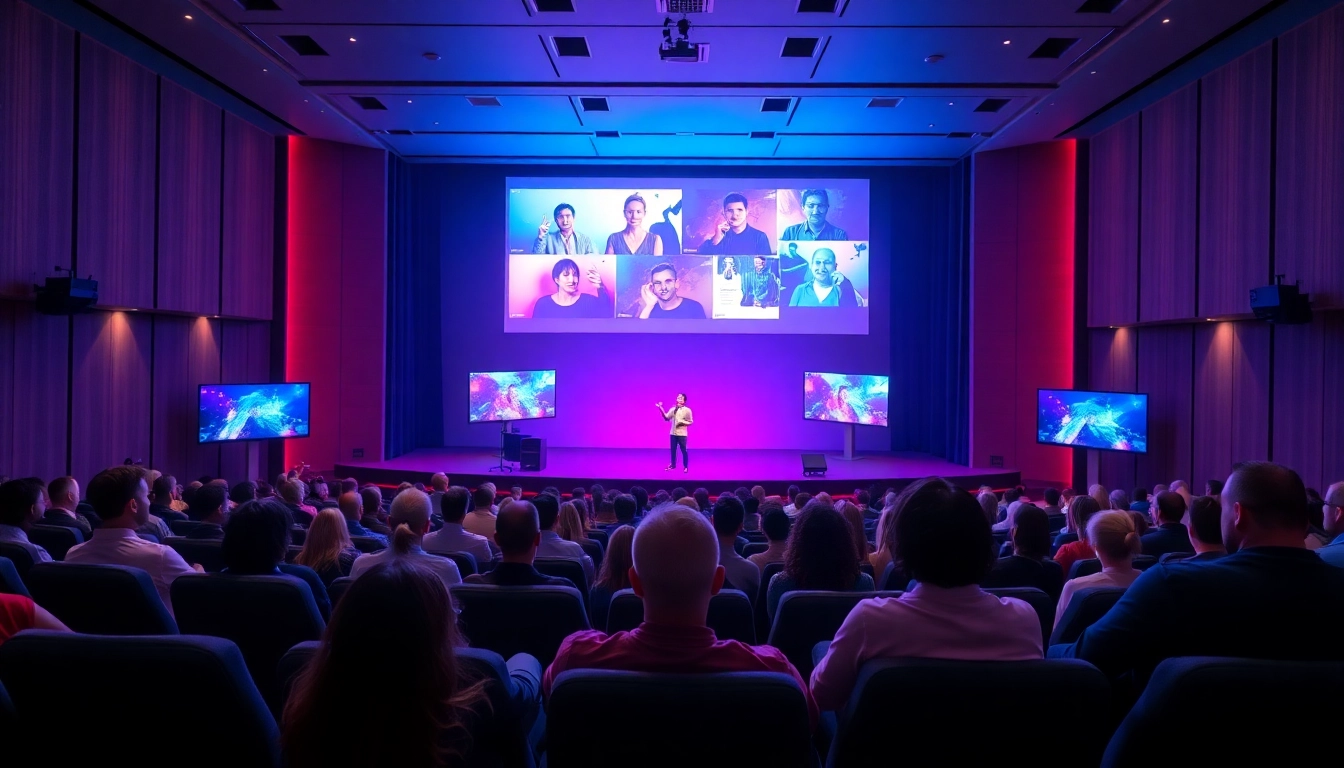Understanding the Virtual Audience System
What is a Virtual Audience System?
A Virtual Audience System (VAS) is an innovative solution designed to enhance interaction between speakers and participants in virtual events. This system allows event organizers to create an immersive environment for attendees, regardless of their physical location. By employing advanced technology, VAS enables real-time engagement through features such as live polls, Q&A sessions, and feedback mechanisms. The significance of a robust Virtual Audience System cannot be overstated; it transforms passive viewers into active participants, thereby elevating the overall event experience.
Key Components of a Virtual Audience System
A fully functional Virtual Audience System integrates several crucial components that work together to create an engaging and interactive environment. These components include:
- Live Streaming: The foundation of any virtual event, allowing speakers to present content to the audience in real time.
- Interactive Features: Tools such as chat functionalities, in-app polling, and Q&A sessions that facilitate engagement.
- Analytics Dashboard: A backend system that provides data on participant interactions, engagement levels, and feedback.
- User Management: Registration and segmentation tools that allow organizers to manage participant access and interactions effectively.
- Content Delivery Networks (CDNs): Solutions that ensure seamless content streaming to participants across various locations.
Benefits for Event Organizers
The adoption of a Virtual Audience System presents a myriad of benefits for event organizers, notably in enhancing engagement and maximizing reach. Key advantages include:
- Wider Reach: Virtual systems allow organizers to reach global audiences, breaking geographical barriers.
- Cost-Effectiveness: Hosting virtual events typically incurs lower costs compared to in-person gatherings, reducing venue and travel expenditures.
- Enhanced Data Collection: The analytics capabilities of a VAS enable organizers to gather valuable insights into attendee behavior and preferences.
- Flexibility: Hybrid models can be implemented where both live and virtual attendees participate, enhancing inclusivity.
Implementing Your Virtual Audience System
Steps to Set Up a Virtual Audience System
Setting up a Virtual Audience System involves a series of well-defined steps, including:
- Define Objectives: Clearly establish what you aim to achieve with your virtual event, such as engagement metrics or audience reach.
- Select Appropriate Technology: Choose the right platform that supports the required features, such as live streaming and interactive tools.
- Design the Event Experience: Craft an engaging agenda that incorporates different types of content—video, polls, and speakers.
- Conduct Rehearsals: Ensure all speakers are comfortable with the technology and the format through practice runs.
- Launch and Monitor: Execute the event while closely monitoring audience engagement and technical performance.
Choosing the Right Technology and Tools
The technology stack chosen for your Virtual Audience System will significantly impact the success of the event. Key considerations include:
- Platform Features: Look for features that facilitate interaction, such as polls, breakout sessions, and chat functionalities.
- Scalability: Ensure the selected platform can handle the expected number of attendees without performance glitches.
- User Experience: Opt for platforms that are intuitive and easy to navigate for all participants.
- Support and Reliability: Choose tools with robust customer support and a track record of reliability during events.
Integrating with Existing Event Management
To maximize the effectiveness of your Virtual Audience System, it’s crucial to integrate it with existing event management practices. This includes:
- Linking Registration Systems: Ensure the virtual system is synced with registration tools for seamless participant management.
- Marketing Integration: Use marketing automation tools to promote the event and keep participants engaged pre- and post-event.
- Feedback Mechanisms: Incorporate tools to gather participant feedback throughout the event lifecycle, enhancing future planning.
Engagement Strategies for Your Virtual Audience
Interactive Features of a Virtual Audience System
Engagement is a key concern in any virtual event, and your Virtual Audience System should be equipped with features that facilitate interaction. Consider integrating:
- Live Polls and Surveys: Encourage attendees to participate actively by asking for their opinions on relevant topics.
- Q&A Sessions: Create opportunities for audience members to ask questions directly to speakers, fostering a two-way communication channel.
- Breakout Rooms: Allow smaller groups to discuss specific topics, enhancing involvement and networking opportunities.
- Gamification: Introduce elements like quizzes and leaderboards to make participation fun and rewarding.
Best Practices for Audience Engagement
To foster a high level of audience engagement, consider applying the following best practices:
- Set Clear Expectations: Communicate the agenda and expected contributions from attendees ahead of time.
- Encourage Participation: Actively invite comments and responses throughout the event to make participants feel valued.
- Utilize Visuals: Employ visuals such as slides, videos, and infographics to maintain attention and convey information effectively.
- Record the Event: Providing access to recorded sessions post-event can help extend engagement beyond the live setting.
Real-life Examples of Success
Many organizations have successfully implemented Virtual Audience Systems, leading to highly engaging events. For instance, the 2021 Virtual Marketing Summit hosted by XYZ Company utilized interactive polls and breakout sessions, resulting in a 40% increase in audience participation compared to their traditional events. By focusing on audience interaction, they were able to create a community feeling among virtual attendees, which led to positive feedback and strong post-event engagement.
Measuring the Impact of a Virtual Audience System
Key Performance Indicators to Track
In order to effectively measure the success of your Virtual Audience System, it is essential to define and track specific Key Performance Indicators (KPIs), including:
- Participant Numbers: Track the total number of attendees versus the registered participants.
- Engagement Levels: Measure interaction metrics such as poll participation, chat volume, and Q&A submissions.
- Session Feedback: Collect ratings and comments on each session to gauge participant satisfaction and preferences.
- Retention Rate: Analyze how many attendees returned for subsequent sessions or events.
Gathering Audience Feedback and Insights
Collecting feedback is vital for assessing the effectiveness of your Virtual Audience System. Implement strategies such as:
- Post-Event Surveys: Send follow-up surveys to attendees to capture their opinions about the event format, content, and overall experience.
- Live Feedback Tools: Utilize tools during the event that enable real-time feedback on presentations and discussions.
- Social Media Monitoring: Observe discussions on social platforms to gather insights about attendee sentiments and reactions.
Utilizing Data to Improve Future Events
Data collected from previous events should be analyzed to refine future strategies. This can include:
- Identifying Popular Topics: Analyze engagement metrics to see which topics garnered the most interest for future planning.
- Adjusting Interaction Techniques: Use feedback to tweak engagement strategies, ensuring they resonate with the audience.
- Improving Technical Aspects: Identify technical glitches or issues reported by attendees to improve the technical setup of future events.
Future of Virtual Audience Systems
Trends Shaping Virtual Event Engagement
The landscape of virtual events is continually evolving, with several trends shaping the future of Virtual Audience Systems:
- Hybrid Events: Merging online and offline experiences will become more common as attendees seek flexibility.
- Enhanced Personalization: Tailoring the virtual experience based on audience segmentation will help increase engagement and satisfaction.
- Increased Use of Augmented Reality (AR) and Virtual Reality (VR): These technologies are expected to create more immersive experiences, enabling attendees to interact with content in new ways.
Adapting to Technological Advancements
As technology continues to advance, event organizers must remain agile and adapt to new tools and platforms. This might involve:
- Adopting AI Tools: Utilizing AI for data analysis to better understand attendee behavior and tailor experiences accordingly.
- Exploring Emerging Platforms: Regularly assessing new virtual event platforms to find those that offer innovative features to enhance attendee experience.
- Investing in Cybersecurity: Ensuring that attendee data is protected as reliance on digital solutions increases is paramount.
Future-Proofing Your Event Strategy
To secure long-term success with your Virtual Audience System, it’s essential to future-proof your event strategy by:
- Regularly Reviewing Trends: Stay updated on industry trends and emerging technologies that can enhance virtual engagement.
- Building a Flexible Framework: Develop a versatile event structure that can adapt to changes in audience preferences or technological capabilities.
- Establishing Partnerships: Collaborate with tech providers and other stakeholders to enhance the event experience continuously.



